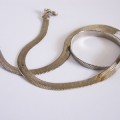Collar
Collars are 12 to 14 inches, with multiple strands that sit very close to the neck. They’re popular at more elegant occasions and look best with V-neck, boat or ballet neck and off-the-shoulder necklines.

17 to 19 inches, a princess necklace hangs just below the collarbone.
If you also have a slender neck, a collar style necklace will show it off nicely.
Choker
15 to 16 inches in length, a choker can be single or multi-stranded.
Chokers are perfect if you want a short necklace without being too snug around the neck.
They work well with many formal dresses, but it depends on what they’re made of: silver or gold looks classic, while cord or leather looks grungy at high-fashion events.
Chokers also help balance a rectangle or heart-shaped face by softening an angular chin.
While this is a versatile length for many clothing types, it’s best to avoid turtlenecks.
Princess
17 to 19 inches, a princess hangs just below the collarbone. This is, by far, the most common and versatile necklace length out there.
Just make sure that your neckline or collar sits clearly higher or lower than the necklace. You’ll find that pendants, lockets and charms tend to come on chains of this length.
If searching for pearls, this is the model length for formal wear.
Matinee
At 20 to 24 inches, this length is considered ideal for the professional office setting while still being casual enough for after work drinks.
Be sure to wear simple tops without much decoration to avoid clashing with the necklace or losing it in a busy pattern.
Women who want to accentuate their cleavage will love this length, as it sits below the collar bones and draws the eye down the chest.
Opera
28 to 34 inches; hangs below the breast area or can be doubled as a choker. This length can also help elongate a round-shaped face.
Evening wear, formal blouses and higher neckline outfits work well with this.
The opera style is ideal if your bust line is more attractive than your neckline, but wear a good bra if your chest will be the focal point.
Rope and Lariat
At over 45 inches, both rope and lariat necklaces cause the eye to sweep down the torso, drawing valuable attention to your curves.
Rope styles hang close to the navel, can be doubled to make a two-strand princess length, or tripled to make a choker or collar.
Lariat styles are not attached at the ends and can be tied in various knots to make a lasting statement.
For pearl wearers, these longer lengths are best suited for relaxed occasions, but can be doubled or tripled to accent for more formal clothing.
Beaded necklaces are extremely popular in this length as well.
Necklace selection is important to more than just women. The standard length for children’s necklaces is about 14 to 16 inches, which allows them plenty of room to grow.
If searching for a men’s necklace, aim for the 18 to 24 inch range, with the 22 inch length being ideal for wearing with a pendant or medallion.
Finally, if you have a treasured pendant that you love wearing no matter what, consider having a few various chain lengths on hand and alternate to suit the occasion.
Also, when gift-giving, never underestimate the versatility of an adjustable length necklace for a truly customizable piece of jewelry.
How to Choose the Right Size for Your Necklace Pendant
Large Pendants
A large pendant can draw attention away from other aspects of the appearance, especially when choosing a bight or shiny color.
When worn with singular color clothing, a large piece of jewelry will become the focal point of the outfit, and is easily a conversation piece.
Larger pendants should be worn with simple necklines and minimal jewelry of other types, and the chains on these large pendants should be carefully chosen, too.
Ensuring that the two complement each other is important, as is making sure that each piece does not clash with the overall outfit.
Small Pendants
Small pendants can be used to make a statement, or simply to tie a look together.
Whether adding a small sparkle via a gemstone, or a touch of personality with a figure or specific shape, the smaller pendants can be chosen with a certain look in mind.
These can also be worn with more delicate and light chains, which will ensure that the attention is paid to the pendant, not what it hangs from.
Consider the Occasion
Many pieces can be worn in many different ways, regardless of the size.
Buying a pendant with an adjustable chain can help to make the piece versatile – keeping the chain shortened for an elegant look, or letting it hang lower for a more casual occasion.
Just because a piece of jewelry looks nice or catches a person’s eye does not mean that it is appropriate for any setting.
Depending on the other people who will be in attendance, some pendants may be more “right” for some situations than others.
Using good judgment is an important thing to consider when making a purchase, because depending on the lifestyle of the owner, size for pendants does matter.
Matching Outfits and Pendants
A pendant’s size should not distract others completely from the rest of the outfit. It is OK to make a statement with one, but the pendant should not be the only thing others notice.
The wearer’s hairstyle should be taken into consideration when choosing jewelry, as loose, long hair may tangle in long chains or around large pieces, and depending on the color, small pendants may become lost in the tresses.
On the other hand, a large pendant paired with short or pinned up hair will draw attention to the upper body, and a smaller piece may look more polished with a sleek, pulled back but over the shoulder ponytail.














